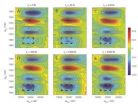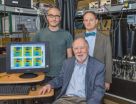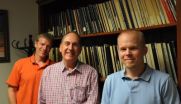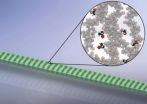(Press-News.org) From allowing our eyes to see, to enabling green plants to harvest energy from the sun, photochemical reactions – reactions triggered by light – are both ubiquitous and critical to nature. Photochemical reactions also play essential roles in high technology, from the creation of new nanomaterials to the development of more efficient solar energy systems. Using photochemical reactions to our best advantage requires a deep understanding of the interplay between the electrons and atomic nuclei within a molecular system after that system has been excited by light.
A major advance towards acquiring this knowledge has been reported by a team of researchers with the U.S. Department of Energy (DOE)'s Lawrence Berkeley National Laboratory (Berkeley Lab) and the University of California (UC) Berkeley.
Graham Fleming, UC Berkeley's Vice Chancellor for Research and a faculty senior scientist with Berkeley Lab's Physical Biosciences Division, led the development of a new experimental technique called two-dimensional electronic-vibrational spectroscopy (2D-EV). By combining the advantages of two well-established spectroscopy technologies – 2D-electronic and 2D-infrared – this technique is the first that can be used to simultaneously monitor electronic and molecular dynamics on a femtosecond (millionth of a billionth of a second) time-scale. The results show how the coupling of electronic states and nuclear vibrations affect the outcome of photochemical reactions.
"We think that 2D-EV, by providing unprecedented details about photochemical reaction dynamics, has the potential to answer many currently inaccessible questions about photochemical and photobiological systems," says Fleming, a physical chemist and internationally acclaimed leader in spectroscopic studies of events that take place on the femtosecond time-scale. "We anticipate its adoption by leading laboratories across the globe,"
Fleming is the corresponding author of a paper in the Proceedings of the National Academy of Sciences (PNAS) titled "Correlating the motion of electrons and nuclei with two-dimensional electronic–vibrational spectroscopy." Co-authors are Thomas Oliver and Nicholas Lewis, both members of Fleming's research group.
Fleming and his research group were one of the key developers of 2D electronic spectroscopy (2D-ES), which enables scientists to follow the flow of light-induced excitation energy through molecular systems with femtosecond temporal resolution. Since its introduction in 2007, 2D-ES has become an essential tool for investigating the electronic relaxation and energy transfer dynamics of molecules, molecular systems and nanomaterials following photoexcitation. 2D infrared spectroscopy is the go-to tool for studying nuclear vibrational couplings and ground-state structures of chemical and complex biological systems.
"Combining these two techniques into 2D-EV tells us how photoexcitation affects the coupling of electronic and vibrational degrees of freedom," says Oliver. "This coupling is essential to understanding how all molecules, molecular systems and nanomaterials function."
In 2D-EV, a sample is sequentially flashed with three femtosecond pulses of laser light. The first two pulses are visible light that create excited electronic states in the sample. The third pulse is mid-infrared light that probes the vibrational quantum state of the excited system. This unique combination of visible excitation and mid-infrared probe pulses enables researchers to correlate the initial electronic absorption of light with the subsequent evolution of nuclear vibrations.
"2D-EV's ability to correlate the initial excitation of the electronic–vibrational manifold with the subsequent evolution of high-frequency vibrational modes, which until now have not been explored, opens many potential avenues of fruitful study, especially in systems where electronic–vibrational coupling is important to the functionality of a system," Fleming says.
As a demonstration, Oliver, Lewis and Fleming used their 2D-EV spectroscopy technique to study the excited-state relaxation dynamics of DCM dye dissolved in a deuterated solvent. DCM is considered a model "push-pull" emitter – meaning it contains both electron donor and acceptor groups - but with a long-standing question as to how it fluoresces back to the ground energy state.
"From 2D-EV spectra, we elucidate a ballistic mechanism on the excited state potential energy surface whereby molecules are almost instantaneously projected uphill in energy toward a transition state between locally excited and charge-transfer states before emission," Oliver says. "The underlying electronic dynamics, which occur on the hundreds of femtoseconds time-scale, drive the far slower ensuing nuclear motions on the excited state potential surface, and serve as an excellent illustration for the unprecedented detail that 2D-EV will afford to photochemical reaction dynamics."
One example of how 2D-EV might be applied is in the study of rhodopsin, the pigment protein in the retina of the eye that is the primary light detector for vision, and carotenoids, the family of pigment proteins, such as chlorophyll, found in green plants and certain bacteria that absorb light for photosynthesis.
"The nonradiative energy transfer in rhodopsin and carotenoids is thought to involve the breakdown of one of the most widely used approximations of quantum mechanics, the Born-Oppenheimer approximation, which states that since motion of electrons are far faster than nuclei, as represented by vibrational motion, the nuclei respond to changes in electronic states," Oliver says. "With 2D-EV, we will be able to directly correlate the degrees of electronic and vibrational freedom and track their evolution as a function of time. It's a chicken and egg kind of problem: Do the electrons or nuclei move first? 2D-EV will give us insight into whether or not the Born-Oppenheimer approximation is still valid in these cases."
For nanomaterials, 2D-EV should be able to shed much needed light on how the coupling of phonons – atomic soundwaves – with electrons impacts the properties of carbon nanotubes and other nanosystems. 2D-EV can also be used to investigate the barriers to electron transfer between donor and acceptor states in photovoltaic systems.
"We are continuing to refine the 2D-EV technology and make it more widely applicable so that it can be used to study lower frequency motions that are of great scientific interest," Oliver says.
INFORMATION:
This research was funded by the DOE Office of Science and the National Science Foundation.
Lawrence Berkeley National Laboratory addresses the world's most urgent scientific challenges by advancing sustainable energy, protecting human health, creating new materials, and revealing the origin and fate of the universe. Founded in 1931, Berkeley Lab's scientific expertise has been recognized with 13 Nobel prizes. The University of California manages Berkeley Lab for the U.S. Department of Energy's Office of Science. For more, visit http://www.lbl.gov.
The DOE Office of Science is the single largest supporter of basic research in the physical sciences in the United States and is working to address some of the most pressing challenges of our time. For more information, please visit science.energy.gov.
Dynamic spectroscopy duo
2-D electronic-vibrational spectroscopy technique provides unprecedented look into photochemical reaction
2014-06-17
ELSE PRESS RELEASES FROM THIS DATE:
Why species matter
2014-06-17
UC Santa Barbara doctoral candidate Caitlin Fong travels to French Polynesia often but not for vacation. She goes there to study a coral reef ecosystem influenced by human impacts such as overfishing and nutrient pollution.
Her work focuses not only on biological changes but also methods scientists use to determine within-group group responses to ecological processes. The findings are published in ESA Ecology, a journal of the Ecological Society of America.
Fong and Peggy Fong, a professor in UCLA's Department of Ecology and Evolutionary Biology, conducted a study assessing ...
Not so fast -- our fishy friends can also feel pain
2014-06-17
Do you still believe that fish are dumb and cannot feel pain? That we do not have to worry much about how they are cared for or caught? Think again, says Culum Brown of Macquarie University in Australia, in a review article in Springer's journal Animal Cognition. The research notes that fish cognition and their sensory perception are generally on par with that of other animals. Brown therefore argues that more consideration should be given to fish welfare and anti-cruelty issues.
The Australian researcher says that most people rarely think about fish other than as food, ...
$2.4 million NIH center grant to develop a cleaner, healthier environment in Detroit
2014-06-17
DETROIT — With over $2.4 million in new federal funding, Wayne State University researchers, regional collaborators at Henry Ford Health System, the University of Michigan and Michigan State University, and community partners will study how exposures to stressors that are prevalent in the urban industrialized environment — both chemical and non-chemical — impact human health in Detroit and beyond.
The grant, Center for Urban Responses to Environmental Stressors (CURES), is one of approximately 20 select P30 Core Centers funded by the National Institute of Environmental ...
Do 'walkable' neighborhoods reduce obesity, diabetes?
2014-06-17
June 17, 2014 (San Francisco) – People who live in neighborhoods that are conducive to walking experienced a substantially lower rate of obesity, overweight and diabetes than those who lived in more auto-dependent neighborhoods, according to a pair of studies presented at the American Diabetes Association's 74th Scientific Sessions®.
Researchers in Canada compared adults living in the most and least "walkable" metropolitan areas in southern Ontario and found a lower risk of developing diabetes over a 10-year period for those who lived in neighborhoods with less sprawl, ...
Heparin derivative suppresses neuroblastoma tumor growth
2014-06-17
DURHAM, N.C. -- Researchers at Duke Medicine have identified a new strategy for treating neuroblastoma using a modified version of heparin, a century-old injectable drug that thins the blood to prevent clots from forming.
The study, conducted in mice and published June 17, 2014, in the Journal of Clinical Investigation, found that when heparin is altered to remove its blood-thinning properties, it can suppress and shrink neuroblastoma tumors without causing severe bleeding.
"Our research translates mechanistic insights about heparin into a potential new therapy for ...
Urban Water Management Workshop stresses more collaboration and innovation
2014-06-17
RIVERSIDE, Calif. — Where sustainability of water management is concerned, we must pay more attention to long-term solutions. Efficient water management and policy ought to be promoted at the local level. And a "portfolio approach" to water management is encouraged, one that includes information campaigns, different types of pricing, supply and reuse options, and technology-based rebate programs.
These are some of the key messages that emerged from the first Urban Water Management Workshop that took place earlier this month at the University of California, Riverside.
Sponsored ...
Swell new sensors
2014-06-17
WASHINGTON D.C., June 17, 2014 – Using microscopic polymer light resonators that expand in the presence of specific gases, researchers at MIT's Quantum Photonics Laboratory have developed new optical sensors with predicted detection levels in the parts-per-billion range. Optical sensors are ideal for detecting trace gas concentrations due to their high signal-to-noise ratio, compact, lightweight nature, and immunity to electromagnetic interference.
Although other optical gas sensors had been developed before, the MIT team conceived an extremely sensitive, compact way ...
Ultra-thin wires for quantum computing
2014-06-17
WASHINGTON D.C., June 17, 2014 - Take a fine strand of silica fiber, attach it at each end to a slow-turning motor, gently torture it over an unflickering flame until it just about reaches its melting point and then pull it apart. The middle will thin out like a piece of taffy until it is less than half a micron across -- about 200 times thinner than a human hair.
That, according to researchers at the Joint Quantum Institute at the University of Maryland, is how you fabricate ultrahigh transmission optical nanofibers, a potential component for future quantum information ...
Study reveals conditions linked to deadly bird flu and maps areas at risks
2014-06-17
BEIJING, CHINA (17 June 2014)—A dangerous strain of avian influenza, H7N9, that's causing severe illness and deaths in China may be inhabiting a small fraction of its potential range and appears at risk of spreading to other suitable areas of India, Bangladesh, Vietnam, Indonesia and the Philippines, according to a new study published today in the journal Nature Communications.
Researchers from the Université Libre de Bruxelles (ULB), the International Livestock Research Institute (ILRI), Oxford University, and the Chinese Center of Disease Control and Prevention analyzed ...
Potential cholesterol lowering drug has breast cancer fighting capabilities
2014-06-17
COLUMBIA, Mo. – Researchers at the University of Missouri have proven that a compound initially developed as a cholesterol-fighting molecule not only halts the progression of breast cancer, but also can kill the cancerous cells.
"Cholesterol is a molecule found in all animal cells and serves as a structural component of cell membranes," said Salman Hyder, the Zalk Endowed Professor in Tumor Angiogenesis and professor of biomedical sciences in the College of Veterinary Medicine and the Dalton Cardiovascular Research Center at MU. "Because tumor cells grow rapidly they ...
LAST 30 PRESS RELEASES:
Researchers use robotics to find potential new antibiotic among hundreds of metal complexes
Gut bacteria changes at the earliest stages of inflammatory bowel disease
Scientists develop new way to “listen in” on the brain’s hidden language
Brain research: “Pulse generators” grow and shrink as memories are formed
For teens, any cannabis use may have impact on emotional health, academic performance
School meals could unlock major gains for human and planetary health
Menopause hormone therapy does not appear to impact dementia risk
Signature patterns of brain activity may help predict recovery from traumatic brain injury
Dresden study uncovers new key mechanism in cancer cells
New species are now being discovered faster than ever before, study suggests
Cannabis-based products show limited short-term benefit for chronic pain, with increased risk of adverse effects
Cannabis products with more THC slightly reduce pain but cause more side effects
Clearing the brain of aging cells could aid epilepsy and reduce seizures
Brain injuries linked with potential risk of suicide, new study finds
New technique lights up where drugs go in the body, cell by cell
New study finds movement of fishing fleets can reveal shifts in marine ecosystems
Embargoed: New evidence points to potential treatment for vascular dementia
Study uncovers disrupted brain balance in alcohol dependence
Working in groups can help Republicans and Democrats agree on controversial content moderation online
Structural findings reveal how distinct GPCR ligands create different levels of activation
Anything-goes “anyons” may be at the root of surprising quantum experiments
UC review: Maximizing workplace opportunity for veterans
From generation to complex control: Metasurfaces make perfect vortex beams "within reach"
Thin-film lithium niobate-based detector: recent advances and perspectives
Exploring why some people may tend to persistently make bad choices
How cells balance their protein levels
Nirsevimab vs RSVpreF vaccine for RSV–related hospitalization in newborns
Effectiveness and impact of maternal RSV immunization and nirsevimab on medically attended RSV in US children
AI gives scientists a boost, but at the cost of too many mediocre papers
Next-generation vision model maps tree growth at sub-meter precision
[Press-News.org] Dynamic spectroscopy duo2-D electronic-vibrational spectroscopy technique provides unprecedented look into photochemical reaction








